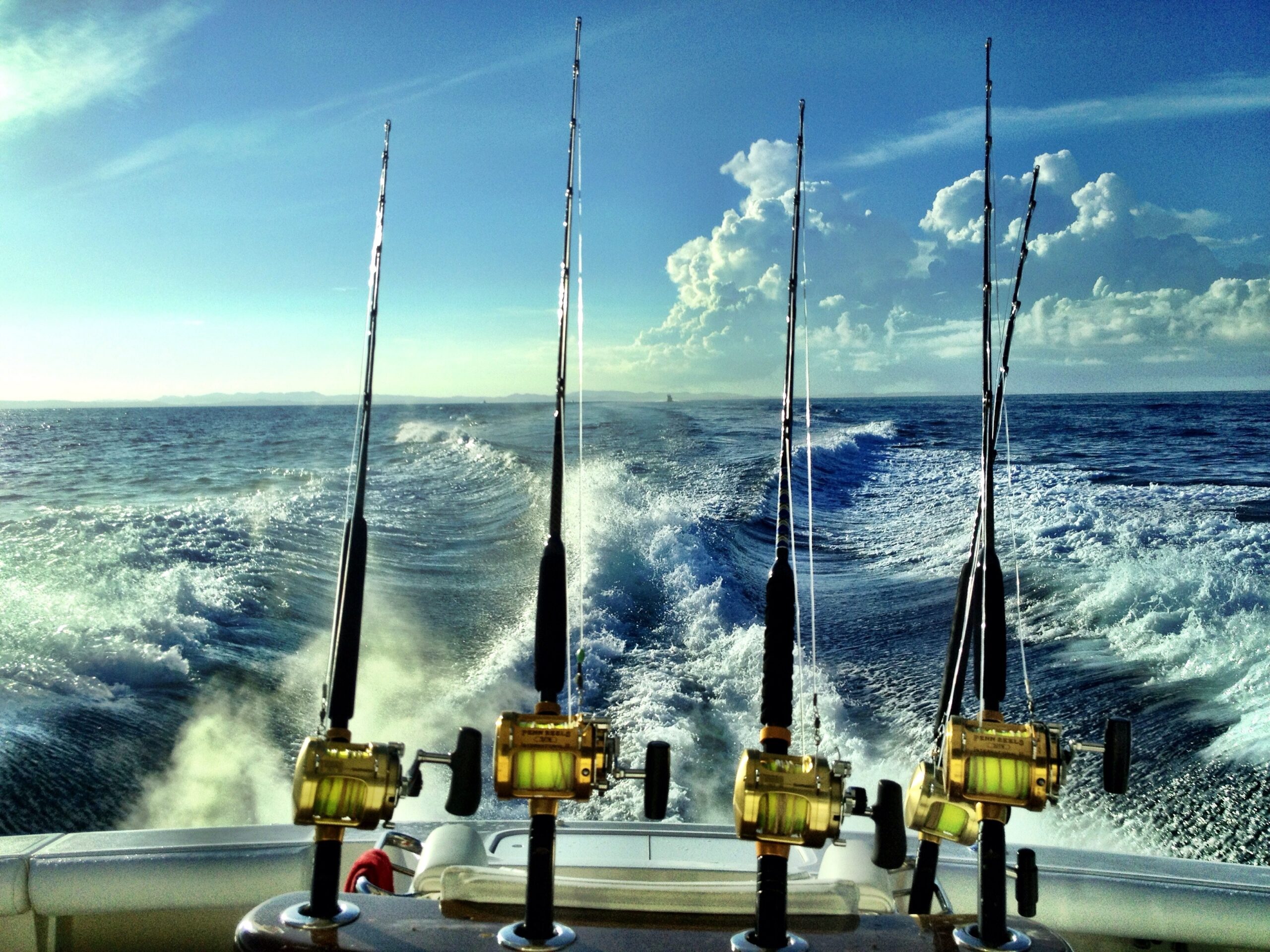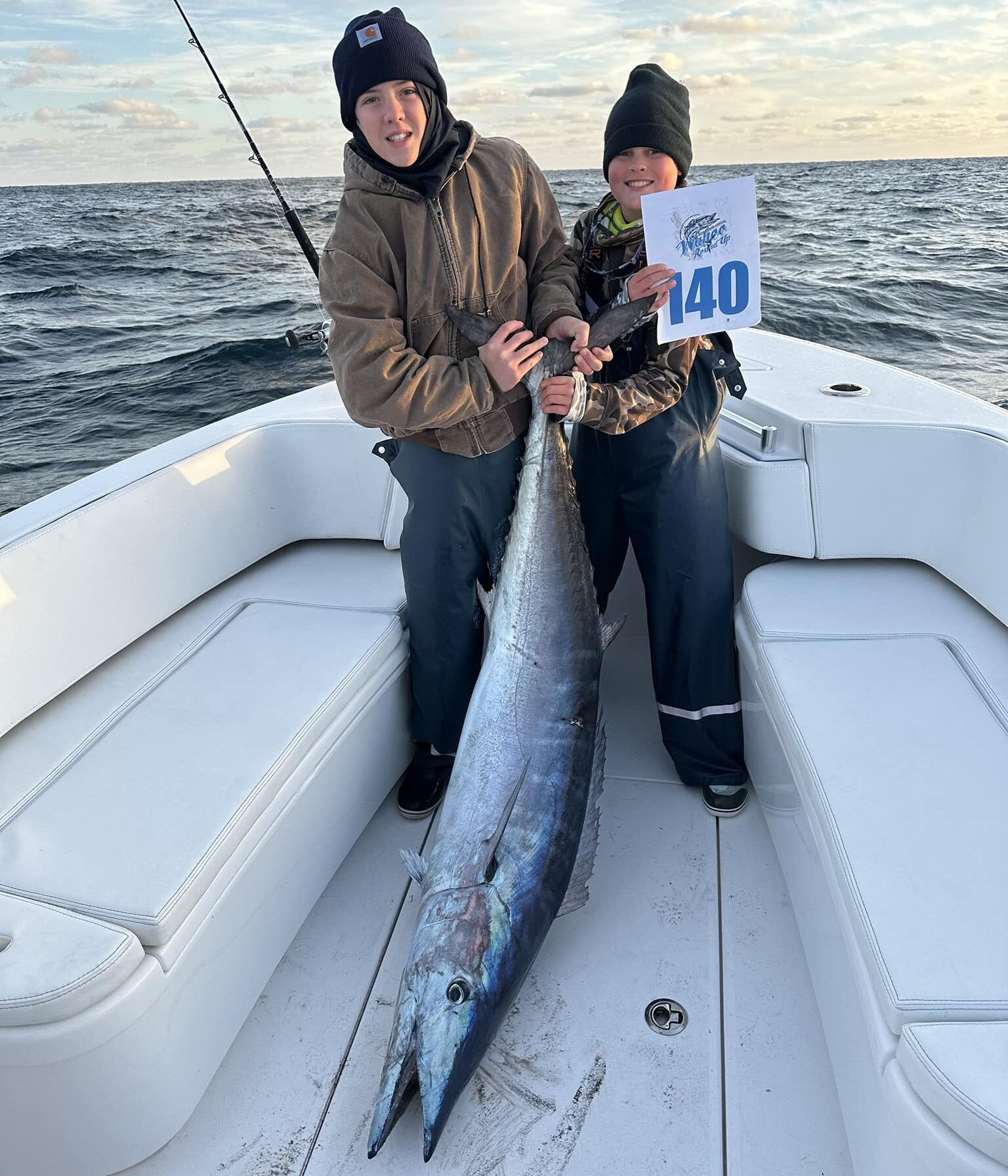Last Updated on March 7, 2025 by Eric Bonneman

Wahoo are one of the most sought-after pelagic gamefish off the coast of St. Augustine, known for their blistering speed, aggressive strikes, and powerful fights. Anglers pursuing them in late winter face a rewarding but demanding challenge that requires the right approach, a solid understanding of the species, and a willingness to battle one of the ocean’s fastest predators.
While wahoo can be caught year-round, late winter presents a unique opportunity due to shifting water temperatures, bait migrations, and reduced fishing pressure. This time of year can also be more physically demanding, with rougher sea conditions and unpredictable weather adding an extra layer of difficulty to an already challenging fishery.
Understanding Wahoo: Biology and Behavior
Wahoo (Acanthocybium solandri) are sleek, torpedo-shaped fish built for speed. They belong to the mackerel family and can reach speeds over 60 mph, making them one of the fastest fish in the ocean. Their long, slender bodies are covered in shimmering blue and silver scales, with vertical tiger-like stripes running along their sides. These stripes fade quickly after death, a characteristic that helps distinguish freshly caught fish from those that have been out of the water longer.
They typically grow to lengths between four and five feet, with some specimens exceeding six feet and weighing over 100 pounds. The average wahoo caught off St. Augustine is often between 20 and 60 pounds, but larger fish are always a possibility, especially in winter.
Wahoo have razor-sharp teeth designed for slicing through baitfish with ease. Unlike many other pelagic fish, which rely on brute force or suction to engulf prey, wahoo use their teeth to shear bait into pieces, often attacking from the side before circling back to consume what’s left. This hunting method makes them notorious for short strikes and missed hookups, which is why rigging and technique play a crucial role in success.
They are solitary hunters or move in small, loose packs, preferring deep blue water near structure, temperature breaks, and strong currents. Their diet consists primarily of smaller fish such as flying fish, bonito, and various species of mackerel, as well as squid. When bait concentrations are high, wahoo can become highly aggressive, striking at lures with reckless abandon.
Wahoo Migration and Late Winter Patterns
Wahoo migrate seasonally along the U.S. East Coast, following warm water and bait concentrations. While they can be caught year-round, winter into early spring is an exceptional time to target them off St. Augustine. During this period, cold fronts push down from the north, interacting with the warm Gulf Stream waters offshore. This creates ideal conditions, as wahoo often stack up along temperature breaks and underwater structure, hunting along these edges.
The most productive wahoo fishing grounds in late winter are typically 50 to 100 miles offshore, where the continental shelf drops into deep water, providing the right mix of structure, current, and bait. The 100-fathom curve, which marks depths of around 600 feet, is a key area where wahoo frequently gather. However, they can also be found at depths ranging from 150 to 600 feet, depending on water temperature and bait movements.
Wahoo are highly influenced by their prey, often hunting in the same areas where blackfin tuna, bonito, and flying fish are abundant. Their presence is also dictated by strong currents and eddies that spin off the Gulf Stream, which trap baitfish and create isolated feeding zones.
Tidal movements and moon phases also play a role in wahoo activity, with feeding increasing during new and full moons when currents are strongest. Barometric pressure shifts can also impact their behavior, as sudden drops in pressure can push wahoo deeper while stable, high-pressure days often see them feeding closer to the surface.

Getting to the Grounds
Reaching prime wahoo fishing off St. Augustine requires a capable offshore vessel, as the best action is often found beyond the 100-fathom curve. This means running well beyond the nearshore reefs and into bluewater territory. Many fishermen target wahoo near ledges, drop-offs, and seamounts where bait congregates.
One of the most well-known areas is the edge of the Gulf Stream, which shifts based on conditions but generally lies around 60 to 80 miles offshore. Within this range, anglers look for underwater high spots, ridges, and changes in bottom contour that create upwellings, bringing nutrient-rich water to the surface. These areas attract baitfish, which in turn draw in wahoo.
Making a run this far offshore requires careful planning. Boats under 25 feet are generally not recommended unless conditions are ideal, as winter seas can be rougher than in summer. A fuel range of at least 200 miles is necessary for a safe round trip, and strong Gulf Stream currents, often moving at speeds of two to five knots, can affect drift speed and trolling spread control.
The Setup: Tackle and Techniques
Wahoo fishing requires specialized tackle capable of handling their speed, strength, and razor-sharp teeth. Standard offshore setups designed for trolling are the most effective, with gear built to withstand long runs and aggressive strikes.
Rods and Reels
Heavy-duty trolling rods paired with high-speed conventional reels are the standard for wahoo fishing. These rods typically fall within the 30- to 130-pound class, with lengths ranging from five and a half to seven and a half feet, offering the best combination of leverage and control. Rods with fast or extra-fast action help drive hooks into a wahoo’s bony mouth, while a stiff backbone prevents excessive flex during the fight.
Reels should feature a 6:1 or higher gear ratio to quickly pick up slack when a wahoo charges the boat. Line capacities of 500 or more yards of 50- to 80-pound mono or braid are essential, as large fish can take significant runs. Lever-drag reels are preferred, as they allow smoother adjustments during the fight.
Line and Leaders
Since wahoo have sharp teeth, wire leaders are a must. Many fishermen use multi-strand cable between 90 and 200 pounds for durability, or single-strand wire between 100 and 150 pounds for stealth. A standard setup includes:
- Mainline: 50- to 80-pound braid or monofilament
- Shock Leader: 100- to 150-pound fluorocarbon for abrasion resistance
- Wire Bite Leader: 3 to 5 feet of 90- to 200-pound test wire
Lures and Baits
Wahoo are commonly caught using high-speed trolling, with lures pulled at speeds of 12 to 18 knots. Effective lures include:
- Bullet-head lures with jet heads or skirts
- Deep-diving plugs that can reach depths of 20 to 30 feet
- Skirted ballyhoo rigs with a double-hook setup
- Weighted trolling baits with 24- to 48-ounce inline weights or planers to keep them 30 to 50 feet down

The Fight: Power and Speed
Wahoo hit hard and fast, with initial runs that can strip 200 or more yards of line in under 10 seconds. Their speed makes them a challenge from the moment they strike, but what makes them especially difficult to fight is their unpredictable movement. Unlike fish that rely on endurance, wahoo fight in bursts, making sharp turns, sudden accelerations, and erratic changes in direction that force anglers to stay fully engaged throughout the battle.
Handling a wahoo fight requires not only strong tackle but physical endurance from the angler. The force of their initial run puts immediate strain on the arms, shoulders, and lower back, requiring firm footing and a tight grip to keep control of the rod. As the fish makes each high-speed turn, an angler must constantly adjust their stance and reel rapidly to avoid slack in the line—any momentary lapse in pressure can result in the hook pulling free.
Wahoo often surface during the fight before diving back down, making it difficult to predict when they’ll be ready to bring in. Their streamlined bodies allow them to cut through the water with minimal resistance, meaning even an average-sized fish can feel far heavier than its weight suggests. As fatigue sets in, keeping steady tension becomes even harder, and losing focus for even a second can mean losing the fish entirely.
As wahoo near the boat, they become even more unpredictable. Many will make sudden last-ditch runs when they see the hull, darting away with the same explosive power they had at the start of the fight. This moment is where many fish are lost, either due to an angler easing off the pressure too soon or the fish taking one final burst of speed straight under the boat. A steady, controlled approach is key to ensuring the fish is positioned for a clean gaff shot.
Safely Landing and Handling Wahoo
Getting a wahoo to the boat is one thing—securing it safely is another. Their razor-sharp teeth and powerful thrashing make them a serious hazard if not handled correctly. A firm gaff shot behind the head or through the gill plate helps control the fish, but even after being brought aboard, they can continue to kick violently.
Many anglers immediately tail-rope wahoo to keep them from flopping dangerously across the deck. Some also use a fish bat to stun particularly active fish before unhooking. Extra caution is needed when removing the hook, as even a slight misstep near their teeth can result in a deep cut.
Once secured, wahoo should be iced immediately to maintain their quality. Their meat spoils quickly in warm conditions, so proper cooling is essential for preserving the catch.

Final Thoughts
Wahoo fishing off the coast of St. Augustine in late winter is a true test of skill, endurance, and preparation. From the long offshore run to the explosive fights these fish deliver, every aspect of the pursuit demands commitment. Anglers who take on this challenge are rewarded with one of the most exhilarating offshore experiences available, and for those who put in the effort, the results can be unforgettable.
Few moments showcase that dedication better than the recent success of Owen Holmquist, who was named Top Junior Angler in the Don Combs Wahoo Round Up with an outstanding 82.76-pound wahoo. After his impressive win, Owen stopped by Avid Angler to share his story, giving us firsthand insight into what it takes to land a fish of that caliber. His achievement is a testament to both his skill as an angler and the incredible wahoo fishery off our coast.
At Avid Angler, we take pride in supporting fishermen of all experience levels, whether they’re just getting started or competing in major tournaments. Owen’s success is a reminder of why we do what we do—helping anglers make the most of their time on the water and celebrating the incredible catches that come from it.
Congratulations to Owen on an outstanding catch and well-earned title!
